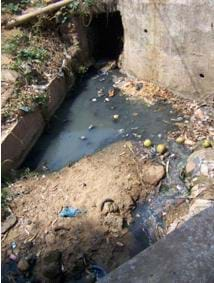
Summary
Students learn the fundamentals of using microbes to treat wastewater. They discover how wastewater is generated and its primary constituents. Microbial metabolism, enzymes and bioreactors are explored in the hands-on associated activities to fully understand the primary processes occurring within organisms.Engineering Connection
Environmental engineers use biological processes to accomplish a variety of environmentally important tasks including wastewater treatment, soil remediation, aquifer remediation and drinking water treatment. Understanding the way that microorganisms grow can help engineers develop more effective and efficient treatment systems.
Learning Objectives
After this lesson, students should be able to:
- Characterize wastewater constituents and define points of origin.
- Describe what happens when raw wastewater is released in natural water bodies.
- Identify biological processes as the primary method of cleaning water.
- Define keywords like enzyme and bioreactor.
- Identify the five stages of growth experienced by microorganisms.
- Explain how engineers determine whether microbes are growing successfully.
- Explain how engineers use microbes to break down pollutants.
Educational Standards
Each TeachEngineering lesson or activity is correlated to one or more K-12 science,
technology, engineering or math (STEM) educational standards.
All 100,000+ K-12 STEM standards covered in TeachEngineering are collected, maintained and packaged by the Achievement Standards Network (ASN),
a project of D2L (www.achievementstandards.org).
In the ASN, standards are hierarchically structured: first by source; e.g., by state; within source by type; e.g., science or mathematics;
within type by subtype, then by grade, etc.
Each TeachEngineering lesson or activity is correlated to one or more K-12 science, technology, engineering or math (STEM) educational standards.
All 100,000+ K-12 STEM standards covered in TeachEngineering are collected, maintained and packaged by the Achievement Standards Network (ASN), a project of D2L (www.achievementstandards.org).
In the ASN, standards are hierarchically structured: first by source; e.g., by state; within source by type; e.g., science or mathematics; within type by subtype, then by grade, etc.
NGSS: Next Generation Science Standards - Science
| NGSS Performance Expectation | ||
|---|---|---|
|
HS-PS1-5. Apply scientific principles and evidence to provide an explanation about the effects of changing the temperature or concentration of the reacting particles on the rate at which a reaction occurs. (Grades 9 - 12) Do you agree with this alignment? |
||
| Click to view other curriculum aligned to this Performance Expectation | ||
| This lesson focuses on the following Three Dimensional Learning aspects of NGSS: | ||
| Science & Engineering Practices | Disciplinary Core Ideas | Crosscutting Concepts |
| Apply scientific principles and evidence to provide an explanation of phenomena and solve design problems, taking into account possible unanticipated effects. Alignment agreement: | Chemical processes, their rates, and whether or not energy is stored or released can be understood in terms of the collisions of molecules and the rearrangements of atoms into new molecules, with consequent changes in the sum of all bond energies in the set of molecules that are matched by changes in kinetic energy. Alignment agreement: | Different patterns may be observed at each of the scales at which a system is studied and can provide evidence for causality in explanations of phenomena. Alignment agreement: |
| NGSS Performance Expectation | ||
|---|---|---|
|
MS-LS2-4. Construct an argument supported by empirical evidence that changes to physical or biological components of an ecosystem affect populations. (Grades 6 - 8) Do you agree with this alignment? |
||
| Click to view other curriculum aligned to this Performance Expectation | ||
| This lesson focuses on the following Three Dimensional Learning aspects of NGSS: | ||
| Science & Engineering Practices | Disciplinary Core Ideas | Crosscutting Concepts |
| Construct an oral and written argument supported by empirical evidence and scientific reasoning to support or refute an explanation or a model for a phenomenon or a solution to a problem. Alignment agreement: Science disciplines share common rules of obtaining and evaluating empirical evidence.Alignment agreement: | Ecosystems are dynamic in nature; their characteristics can vary over time. Disruptions to any physical or biological component of an ecosystem can lead to shifts in all its populations. Alignment agreement: | Small changes in one part of a system might cause large changes in another part. Alignment agreement: |
International Technology and Engineering Educators Association - Technology
-
Evaluate ways that technology can impact individuals, society, and the environment.
(Grades
9 -
12)
More Details
Do you agree with this alignment?
State Standards
Florida - Science
-
Assess the need for adequate waste management strategies.
(Grades
9 -
12)
More Details
Do you agree with this alignment?
-
Discuss the effects of technology on environmental quality.
(Grades
9 -
12)
More Details
Do you agree with this alignment?
-
Assess the effectiveness of innovative methods of protecting the environment.
(Grades
9 -
12)
More Details
Do you agree with this alignment?
Introduction/Motivation
Have you ever wondered what happens to your waste when you flush a toilet? Have you ever considered what happens to all the soaps and detergents that go down your drains?
Most people like to be blissfully ignorant of their waste's fate. Yet, how we deal with our waste is of vital importance because of its potentially negative effects on our natural environment and human health.
Wastewater can be a huge source of pathogens and pollution. Environmental engineers focus on cleaning up wastewater before it is released into our environment. In their pursuit of clean water, they bridge many fields of science including traditional engineering, chemistry and biology.
We will explore the use of biological processes in treating wastewater, as well learn a few examples of biological systems use in other fields.
Lesson Background and Concepts for Teachers
Wastewater
Wastewater is produced when water is contaminated with other substances. Every society produces wastewater. In a city, wastewater comes from domestic, industrial and agricultural sources. Domestic sources include homes, stores, schools, offices and even parks. Within a house, all the water that goes into the sewer system is considered wastewater, including water from showers, sinks, washing machines and toilets.
Industrial sources of wastewater are varied. Everything from cars to computers require water for the manufacturing process. Water is used to clean parts, dissolve chemicals and many other purposes. Industrial wastewater is different from domestic wastewater because it usually has more chemicals and metals dissolved in it. Most industries have their own wastewater treatment systems that cater to the unique properties of their wastewater.
Agricultural wastewater is produced from agricultural practices. Overwatering crop fields can wash away fertilizers and pesticides, causing water contamination by those substances. Another source of agricultural wastewater is the runoff from poultry, fish and cattle farming. In these cases, water is used to clean cages and wash "away" animal feces. This wastewater is usually much more contaminated than domestic sources, and has the greatest possibility of finding its way into rivers and streams.
This lesson focuses on domestic wastewater treatment, although the other sources of wastewater should not be neglected when discussing wastewater. It is important to understand that the same biological processes that we use to treat domestic wastewater can also be used to treat industrial and agricultural wastewater.
Wastewater Constituents
Before we can understand wastewater's effects on natural systems and the ways to treat it, we need to understand what is in it. Most of wastewater is simply water! Everything else is found in very small amounts, yet they are in high enough concentrations that they drastically affect water quality.
Of great concern to human health, wastewater contains a number of microorganisms. The diversity of these microorganisms can be impressive. Microbes found in wastewater come primarily from feces, but some microbes are also brought into the system when people take showers and wash their hands. Although not all of the microbes present in wastewater are pathogens, or disease causing organisms, many are. Some of the most prevalent diseases worldwide are a result of inadequate sanitation. Due to their health risk, microbes need to be removed or destroyed in the wastewater treatment process.
Organic molecules, or molecules that contain carbon and are biologically derived, are found in abundance in wastewater. Organic molecules come from human waste as well as food waste. These molecules are problematic as they contain large amounts of energy. Microbes view these molecules the same way we view candy bars. They can readily consume the molecules as a food source. We will talk more about this later.
Nutrients are also readily found in wastewater. One way to think about nutrients is to think of them as dissolved fertilizers that plants can use to grow. In wastewater, nitrogen and phosphorous are the two most important nutrients that people consider, as they are often the two nutrients of highest demand by plants.
Wastewater also contains small amounts of salts and metals. These tiny dissolved constituents are difficult to remove and are often found in very small concentrations. Our body gets rid of metals and nutrients on a regular basis through urine. Once excreted by our bodies, these salts and metals find their way into wastewater. The concentrations of these are usually so low that they are not removed before being returned to natural environments.
Lastly, and quite importantly, wastewater contains trace amounts of pharmaceutical and personal care products. Every time we take medicine or shower, a small amount of these products enters the wastewater stream. Anything from Advil to caffeine can end up passing through our bodies into wastewater. Usually, what passes through our system is in very small concentrations. However, we are still not sure of the effect these compounds might have on wildlife, nor are we sure if our current treatment systems are effective at breaking down these compounds. We will focus on the removal of organic molecules, microorganisms and nutrients found within wastewater.
Wastewater's Impact on the Environment
When raw wastewater enters a river or lake, it throws off the natural balance of that system. The introduction of large quantities of organic compounds as well as nutrients enables some organisms to grow uncontrolled. It is similar to dumping tons of food on a very hungry community. The addition of wastewater represents a physical change to the ecosystem, which has a direct impact on microbial population: the organisms that can use organic molecules and nutrients for growth start to thrive. Usually, bacteria and algae are the only organisms that benefit from the influx of wastewater. This explosion of microbial life is called eutrophication, depicted in Figure 1. The change in color of the water provides observers with empirical evidence that the wastewater input results in the booming microbial population. Most bacteria, just like us, require oxygen to consume organics. Thus, as they begin consuming what is in the wastewater they also begin consuming all of the oxygen in the water. Larger organisms like fish and water insects, which are vital to natural ecosystems, require dissolved oxygen in the water to survive. As the oxygen is depleted, these larger organisms begin to die off.
A similar problem is encountered when algae populations begin to explode due to the nutrients in wastewater. However, algae add oxygen to the water, at least at the beginning. What usually happens is that the algae population explodes to the point at which they consume all of the nutrients in the wastewater and begin to die off due to a lack of nutrients. As they die, they become food to bacteria, which consume all the oxygen in the water. Both pathways lead to the eventual destruction of a habitat. That is why wastewater treatment focuses on the removal of the organics and nutrients from wastewater.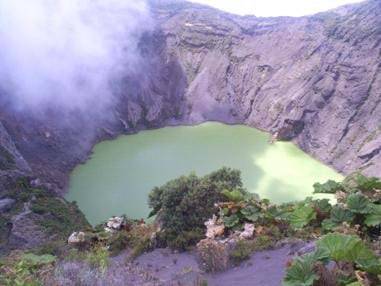
Mimicking Nature
How exactly do we remove the organics and nutrients from wastewater? The answer might be surprising! Why don't we mimic the same process that occurs in nature but in a controlled environment? We know that the microbes are breaking down the organic molecules and we know that other microbes can use the nutrients to grow, thereby removing the nutrients from the water. That is exactly what environmental engineers do to treat wastewater. Environmental engineers create the perfect environment for microbes to thrive and break down as many organics as possible.
Diversity of Microbial Life
What about the really strong types of wastewater? What about the exotic compounds found in some high-strength wastewaters? The fact that such a large variety of microbes exist on this planet is of great benefit to humanity. Each has found a niche habitat, or unique environment, in which to dwell. These habitats range from places of near zero pH to places with pH 10, environments that are typically colder than freezing to places like thermal vents that are near boiling temperature. In addition to being able to withstand harsh environments, microbes can degrade a variety of compounds. Some organisms can readily consume materials that are toxic to most others, such as radioactive material and arsenic (used for genetic material). This diversity allows environmental engineers to select the exact organisms that can withstand the conditions of a specific wastewater and be able to degrade the specific types of organics in that wastewater.
Why are some organisms able to degrade compounds while others are not? Microbes are able to use organics because of specific enzymes that their genetics encode for. Enzymes are biologically derived catalysts. A catalyst is something that speeds up the rate of a reaction but is not consumed by the reaction. Microbes produce these enzymes to speed up the destruction of specific organic molecules. Each enzyme is specific to one molecule. This concept is not that foreign to everyday life. Our own bodies produce enzymes to help us consume the food we eat. For example, a lactose intolerant person's body does not produce the enzyme necessary to breakdown lactose, a sugar commonly found in dairy. In that same way, some microbes are able to generate enzymes that others are unable to produce.
Bioreactors
Once we have selected the right set of microbes, where do we grow them? What conditions affect microbial growth? Engineers and microbiologist grow microbes in devices called bioreactors. These devices that encourage biological activity. Think of it as a microbe's workplace. Refer to the Microbes Know How to Work! activity to assist students with a hands-on way to understand how bioreactors affect microbial growth. To make the microbial community work harder and faster, you make sure the conditions are just right. The acidity of the environment, the temperature and the availability of oxygen are all important factors affecting microbial growth in bioreactors. Most organisms like neutral pH, slightly higher temperatures and considerable aeration, although these factors vary greatly by the type of organism.
Bioreactors are also used when a product that only microbes can make is desired. Alcohol fermentation, the process used to make beer and wine, occurs in a fermenter, which is just one type of bioreactor. Cheese and yogurt production also occurs in a type of bioreactor. These are familiar examples of bioreactors, but the most widely used example of a bioreactor is a wastewater treatment plant. A wastewater treatment plant attempts to create the perfect conditions for microbes to remove the organics and the nutrients from wastewater.
The primary process of a wastewater treatment plant is the aeration basin. This large tank is aerated constantly in order to provide enough oxygen for the microbes to degrade the organics in wastewater. In this process, the microbes utilize large amounts of the nutrients for their own growth.
Working with Microbes—Measuring Growth
When working with microbes, it is important to understand which factors affect growth the most. One way to tell whether or not a microbe enjoys its bioreactor is to see how well it grows in the new environment. Measuring growth with microbes can be a difficult thing to do because of their small size. To accurately measure growth, scientist use a variety of tools to determine cell growth, including direct cell counting and optical density. Students can use the long-term Grow Your Own Algae! activity to experience first-hand the growing cycles of microbes.
Direct cell counting sounds exactly like what it is. Samples from reactors are examined under a microscope. With specialized microscope slides (depicted in Figure 2), you can see exactly how many microbes are in a specific volume. The samples are placed on a tiny grid on the slide. Each box on the grid corresponds to a specific volume of sample. Then, just like counting sheep, the microbes can be counted per grid. The resulting cell count is in cells per volume. This is one of the most common methods for measuring and determining cellular growth and activity.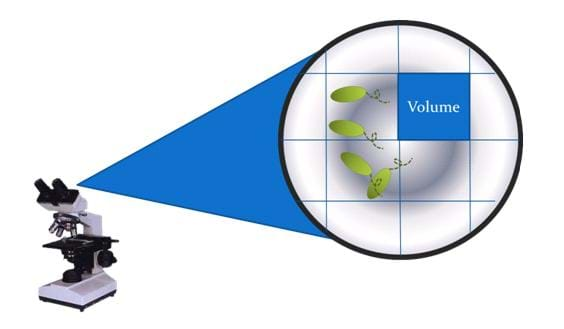
Although direct cell counting can be a useful method of determining growth, easier, more generalized methods exist. Optical density is a method that uses light to measure growth. Cells absorb light. The more cells in a container, the more light absorbed as it passes through. Engineers use this natural phenomenon--optical density--as a tool. They pass light through a container of microbes and measure how much light passes through the container (depicted in Figure 4). Each time an engineer uses this tool, he compares the new value against clean water (his control/blank). The cell growth in a test tube over time depicted in Figure 3 shows that as the number of cells increase, the sample appears murky and allows less light to pass through. 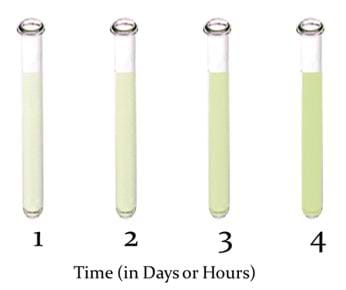
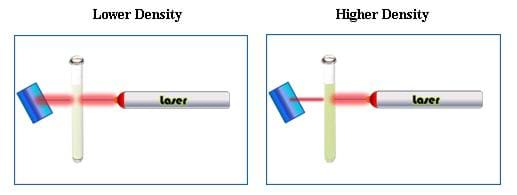
If you were to monitor microbial growth over time and graph it you would end up with a growth curve. A growth curve is a graph that depicts all the life stages experienced by a bacterial community. A generic curve is depicted in Figure 5. When microbes are put in a new environment free of competition and abundant in food, they typically go through four stages of growth: lag phase, exponential growth phase, stationary phase and death phase. In lag phase, the microbes are just warming up to the new environment. They have not started reproducing very quickly yet. What they are really doing is getting used to the new food source. During exponential growth phase, the microbe population explodes and starts growing uncontrollably. In the stationary phase, growth slows down and reaches a point at which the amount of microbes being born is equal to the amount dying.
Microbes enter into stationary phase for a variety of reasons, all of which are related to something changing in their environment. Usually the food source in the environment starts to be depleted, creating an environment cannot sustain an endless number of microbes. Depletion of the food supply is one example of how ecosystem changes can have a direct impact on the microbial population. Another common reason for the microbes to die off is the accumulation of waste products generated by their growth. These waste products can often be toxic to the microorganisms and end up killing them. The last stage, the death phase, occurs when the conditions in the microbe's environment have changed so drastically that bulk of the population starts to die off. 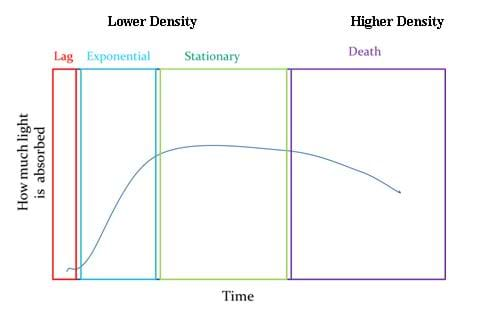
Engineers use direct cell counting and optical density to determine how a microbe's growth rate changes according to different environmental conditions. The goal is to keep the microbes healthy and happy and doing important tasks. With the example of wastewater, it is important to keep the microbes growing in the exponential phase.
Conclusion
Everyday, around the world, engineers design systems that use microbes to clean the water polluted by humans. When carefully monitored, microbes can accomplish a variety of beneficial services and produce valuable products. We are entering a new era in which bioengineering, or putting microbes to work, can help us solve many of challenge that have faced humanity for centuries.
Associated Activities
- Microbes Know How to Work! - Students explore the concept of bioreactors and important parameters that affect microbial growth. They use yeast to break down common table sugar.
- Grow Your Own Algae! - During this long-term activity, students investigate algae's use of nutrients to grow. They learn about the key life stages of microbes.
Vocabulary/Definitions
bioreactors: Devices that create the perfect conditions for microbial growth.
catalyst: A substance that speeds up the rate of a reaction, but is not consumed by the reaction.
direct cell counting: A method for measuring cellular density and growth. Through a microscope, the number of microbes are directly counted in a specific volume of sample.
enzyme: A special protein that serves as a biocatalyst. It speeds up the rates of reactions within an organism. It allows organisms to break down contaminants and food sources.
eutrophication: An explosion of microbial life in a natural body of water that occurs due to an abundance of nutrients and organic molecules.
growth curve: A graph of the growth of a microbial community, from the first time it enters the new environment to its eventual death.
niche habitat: A unique environment in which an organism has found a way to live.
nutrients: Molecules that can serve as fertilizers.
optical density: A generalized method for measuring microbial density and growth. Light is passed through a container with a sample. Light is absorbed by the microbes and the amount of light passing through is measured.
organic molecules: Molecules that are composed of carbon and are biologically derived.
pathogen: A microbe or virus that can cause illness in humans.
Assessment
Pre-Lesson Assessment
Discussion Questions: Solicit, integrate and summarize student responses.
- Where does our waste go after we send it down the toilet or sink? (Expect students to offer suggestions to share with the class. Answer: It goes down the drain, through pipes and into a wastewater treatment plant where pollutants are removed.)
- What would happen if our waste went straight into a river or lake? (Answer: Fish and other animals would end up dying. Explain to them the concept of eutrophication and that the aquatic animals would have no oxygen available to them).
- How can we break down substances before they reach the lakes and rivers? (Answer: We use microbes to break down the pollutants in the wastewater.)
Lesson Summary Assessment
Question Survey: At lesson end, determine students' level of comprehension by asking them a few related questions, such as:
- List three sources of wastewater and give an example of each. (Answer: Residential – water from our sinks, showers and toilets. Industrial - water from chemical manufacturing, industrial processing plants, etc. Agricultural sources - pesticide, herbicide, fertilizer and animal waste-laden water from farms and fields.)
- What happens when wastewater gets into rivers and lakes? (Answer: Bacteria and algae grow like crazy and eventually consume all of the oxygen in the water.)
- What can we do to reduce the amount of pollution in wastewater? (Answer: Use microbes to eat the pollutants.)
- List two common methods of measuring microbe growth.(Answer: Cell counting and optical density.)
- List the four stages of microbe growth. (Answer: Lag, exponential, stationary and death phases.)
- Why do you think that microbes enter the death phase? (Answer: They start running out of food and/or the conditions in the environment start changing, which can cause them to die.)
Homework
Mini Research Report: Have students find out about productive use of microbes that are beneficial to people and our environment: Assign students to research or invent a list of products or processes that are made by or use microbes. Possible answers: Cheese, coffee, yogurt, antibiotics, medicines, yeast-based bread, wine and beer, oil-spill eating bacteria, fermented foods, etc.
Subscribe
Get the inside scoop on all things TeachEngineering such as new site features, curriculum updates, video releases, and more by signing up for our newsletter!More Curriculum Like This

By studying key processes in the carbon cycle, such as photosynthesis, composting and anaerobic digestion, students learn how nature and engineers "biorecycle" carbon. Students are exposed to examples of how microbes play many roles in various systems to recycle organic materials and also learn how ...

Students examine in detail the water cycle components and phase transitions, and then learn how water moves through the human-made urban environment. Students show their understanding of the process by writing a description of the path of a water droplet through the urban water cycle, from the dropl...

Students design and conduct experiments to determine what environmental factors favor decomposition by soil microbes. They use chunks of carrots for the materials to be decomposed, and their experiments are carried out in plastic bags filled with soil.
Copyright
© 2013 by Regents of the University of Colorado; original © 2010 College of Engineering, University of South FloridaContributors
Robert Bair; Patricio Rocha; Tapas K. Das; Dayna Lee MartinezSupporting Program
STARS GK-12 Program, College of Engineering, University of South FloridaAcknowledgements
This curriculum was developed by the USF Students, Teachers and Resources in Sciences (STARS) Program under National Science Foundation grant numbers DGE 0139348 and DGE 0638709. However, these contents do not necessarily represent the policies of the NSF, and you should not assume endorsement by the federal government.
Last modified: May 27, 2019









User Comments & Tips